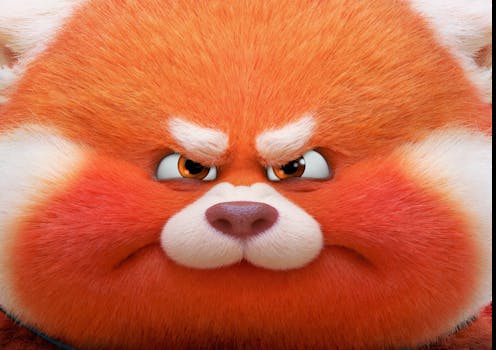
Animation has been conceived as “for children” for decades even though animation pre-dates cinema (the magic lantern show, for example) and was originally made for adults. However, while these films might be for children and often are about children, it’s not always the children who choose these films but the parents.
The complexity of this has been exposed recently with Pixar’s new film, Turning Red. The film focuses on 13-year-old Mei Lee who has followed her mother’s strict guidance throughout her life but is now craving a wilder teenagehood. Her version of this includes hanging out with friends her mother disapproves of and attending a concert by her favourite boy band.
Things get messy when a hereditary curse makes her turn into a panda whenever her emotions get out of hand. For instance, in one scene Mei sees the convenience store clerk she has a crush on and the panda stamps its foot in glee, panting and shouting “awooga!” Unsurprisingly, this scene has become a popular meme and gif on the internet.
The film has been met with a lot of criticism from parents. Mei’s rambunctiousness and rebelliousness have been seen as a bad role model for young viewers and the representations of a young girl’s menstrual cycles and burgeoning sexuality deemed “inappropriate”. But these are all things that happen to real girls Mei’s age, so why should they not be allowed in children’s entertainment?
Reactions to Turning Red show that some audiences still expect girls on screen to behave in certain ways. It raises the question: what type of female childhood is worthy of representation?
No more timid women
Pixar’s owner, the Walt Disney Company, has been central in debates about gender representation through their Princess franchise. These stories are usually about romance with the central female character a young girl who falls in love by the end of the film, preferably with a prince. The origin of this princess-type is Snow White who demonstrates throughout that she is the perfect young woman - beautiful and can tend to a home (as she does with the dwarfs’ house). While there have been alterations to this princess-type, including Belle’s intelligence in Beauty and the Beast, the older princesses are generally pretty and demure, devoid of rich interior lives.
Responding to criticism, Disney has sought to make more empowered princesses. The most recent addition, Moana, was celebrated for her transition from “timid princess to empowered working woman” (although, Moana insists she is “not a Princess”). Turning Red follows suit telling the story of an imperfect girl with relatable characteristics and conundrums. It also is a representation of the Chinese-Canadian experience, which is also not always represented on screen and adds more complexity to the character.
Emotional girls
There are distinct and accepted narrative traits of cinematic girlhood including “heightened, disrupted emotions”. While boys are physically adventurous in films, girls are frequently presented as emotional beings who struggle to come to terms with their various emotions as they age into adolescence and womanhood.
Tellingly, Pixar’s Inside Out mostly takes place within the mind of 11-year-old Riley who experiences emotional turmoil when her family uproots her life when they move from Minnesota to San Francisco. Within Riley’s mind are five main emotional characters that control her actions (Joy, Sadness, Fear, Disgust and Anger). The film’s turning point occurs when Sadness takes over from Anger, leading Riley to confess her unhappiness and learn to accept her new life.
Notably, Anger is voiced by a male comedian (Lewis Black). Anger, as an emotion, is frequently denied for young girls. As film academic Lisa Downing puts it, “our cultural projection of qualities of innocence and passivity onto childhood, and girlhood in particular, denies young girls the capacity to express violent actions or emotions”.
Therefore, part of the response to Turning Red is about the anger Mei experiences and how this anger physically and emotionally tears apart her home, school and city. In Turning Red, girlhood anger is an indomitable force to be reckoned with.
The film even suggests that Mei should be proud of this side of herself. It is important that Mei is able to keep and contain this spirit. It could be said, then, that the panda, while messy and unruly, allows Mei to be her most authentic self as opposed to a traditional view (upheld by the other women in her family) that women should be respectable and demure.
The panda is not purely anger, but is this combustible set of emotions that cause the most strife in the film. Even in the climax of the film when Mei’s mother’s demands that she restrain her beast, Mei responds by gyrating and shaking her butt in an angry and freeing act of bold defiance. There is so much anger from mother and daughter but also love and fear that is not repressed for once but allowed to flow freely. This display is crass, destructive and full blooded. It is, what some might call, “unladylike”.
Princesses huff and puff, stomp their feet and cry in disapproval, frequently frustrated by those around them, but they do not get angry. It is an emotion that is rarely exhibited with violence and destruction in animated projections of girlhood. Instead of criticising girlhood anger, we should celebrate this unique, but accurate, reflection of girlhood and the complexities involved in growing up.
Julie Lobalzo Wright does not work for, consult, own shares in or receive funding from any company or organisation that would benefit from this article, and has disclosed no relevant affiliations beyond their academic appointment.
This article was originally published on The Conversation. Read the original article.







